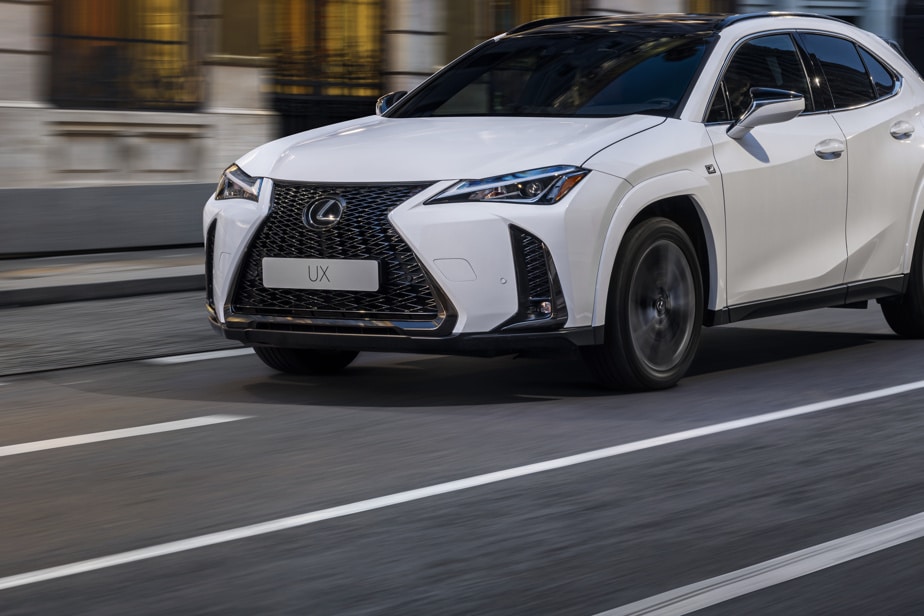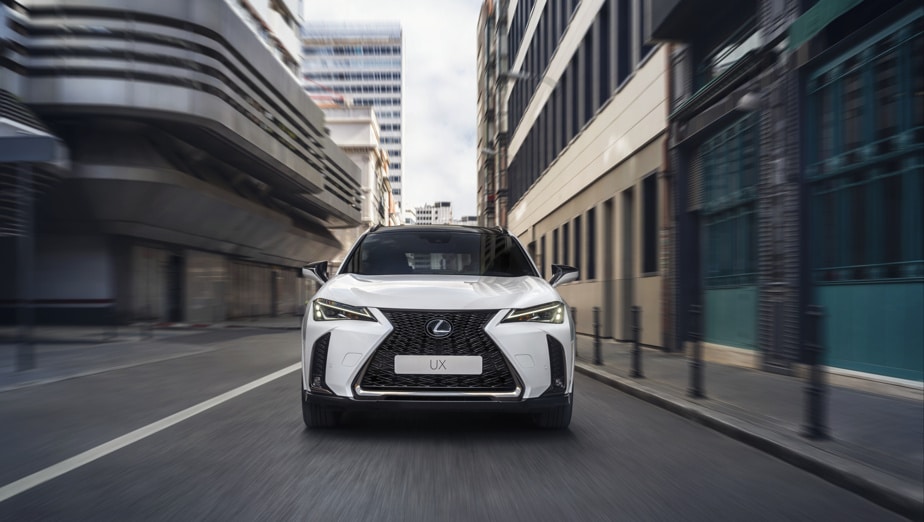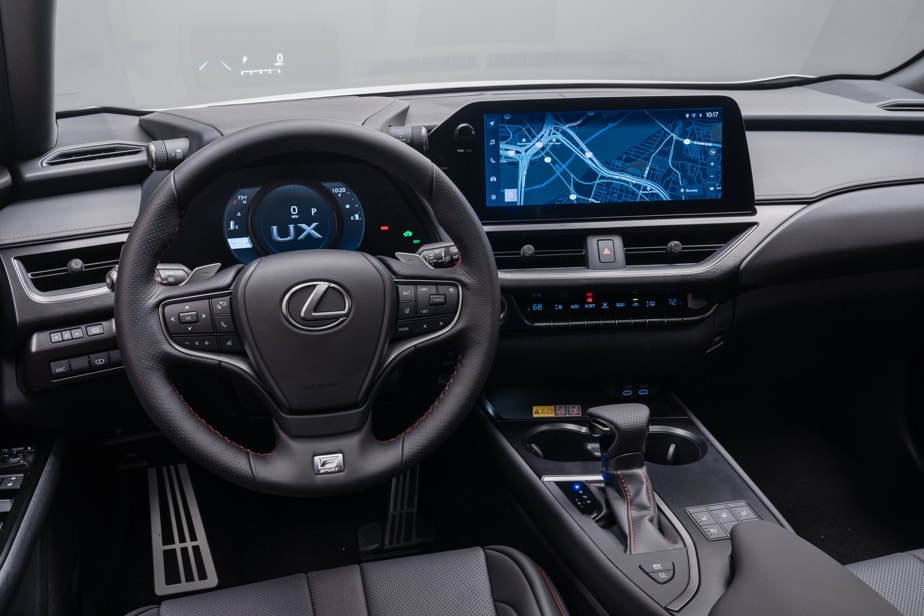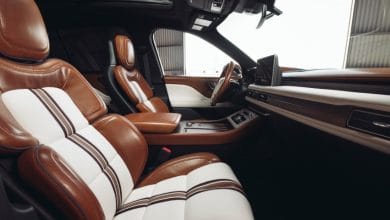
Contents
Design

PHOTO PROVIDED BY LEXUS
From the side, the 2024 Lexus UX 250h crossover displays a pleasant balance thanks to its short overhangs and variations in texture on the sheet metal that drapes the beltline.
Aside from height, the UX has essentially the same dimensions as the Toyota Corolla Cross, the crossover variant of the popular compact car. Aesthetically, however, the belonging to the Lexus brand is palpable. The large hourglass grille which defines the appearance of the manufacturer's models is present and maintained by well-proportioned and angular headlights whose diodes describe hooks. From the side, the crossover displays a pleasant balance thanks to its short overhangs and variations in texture on the sheet metal that drapes the beltline. The rear, which does not have a visible exhaust pipe – undoubtedly to highlight its hybrid mechanics – displays a large transverse light. An aesthetic element that adds refinement to a resolutely Lexus design.
On board

PHOTO PROVIDED BY LEXUS
The interior of the 2024 Lexus UX 250h
The composition of the dashboard, revised for the 2023 model year in order to integrate the latest version of the manufacturer's infotainment system, still looks very Lexus to justify the extra premium. Soft materials are omnipresent and the ergonomics are impeccable thanks to the use of physical buttons for many essential controls, including those for the ventilated-heated seats skillfully placed on the central console. The positioning of the cup holders in front of a – real – gear lever is also very well thought out, which eliminates the possibility of obstructing anything. The steering wheel could nevertheless provide more adjustments to allow more legroom. In this regard, the rear seats display an obvious deficiency in terms of clearance. Cargo space is also limited in volume, especially in height. Flaws that could push some buyers towards the NX compact SUV.
Under the hood

PHOTO PROVIDED BY LEXUS
The powertrain of the 2024 Lexus UX 250h is composed of a 2.0L four-cylinder with a starter-alternator and an electric motor at the front as well as a rear electric motor.
The UX has only been offered with traditional hybrid mechanics since the 2023 model year. This powertrain consists of a 2.0L four-cylinder with a starter-alternator and an electric motor at the front as well as that a rear electric motor is very Toyota in its performance. All in all smooth, this 181 hp engine performs the task adequately, but presents a power curve which sags at times, depending on the dialogue between the various mechanisms. The thermal engine increases the decibels significantly during acceleration, a nasal sound which less suits the desired character of the model. Moreover, its consumption remains reserved, with an estimated 6 L/100 km, which turned out to be 6.3 L/100 km during the test. A figure obtained on highway journeys where the hybrid engine is less efficient.
Behind the wheel

PHOTO PROVIDED BY LEXUS
The chassis of the 2024 Lexus UX 250h seems well supported, presenting the necessary rigidity, but the steering is disjointed on a sensory level.
The comfort of the optional F Sport seats is undeniable from the outset; they find a relevant balance between support and flexibility. They harbor hopes of a certain dynamism, a hypothesis that we learn to qualify rather quickly behind the wheel. Certainly, the chassis of the small crossover seems well supported, presenting the necessary rigidity, but the steering is disjointed on a sensory level. We are therefore sailing in a fog when the time comes to turn this UX into a curve after having negotiated with a not very progressive braking pedal. The all-wheel drive system hardly helps the performance; it has a propensity to strongly enhance forward torque, a consequence of an underpowered rear electric motor. The adaptive suspension also lacks refinement: it does not always mask slight imperfections well, thus transmitting a little too much vibration to the cabin.
Embedded technologies

PHOTO PROVIDED BY LEXUS
The Lexus UX 250 h's optional multimedia system with a 12.3-inch horizontal screen
Lexus' latest multimedia system allows the brand to take a big step forward. Gone is the imperfect touchpad to make way for a large 8″ or 12.3″ screen fixed high enough and closer to the driver for better navigation and consultation. Logos of the most important menus are constantly displayed on the left superimposed and in clear view for quick access. The system is fast, the image is well defined and the animations are fluid, ensuring a modern rendering. The instrumentation, for its part, still comes from this digital and analog mix that only Lexus currently uses. On the model tested with the F Sport 2 package, a physical circle moves sideways on a digital screen to change the construction of the display.
The verdict

PHOTO PROVIDED BY LEXUS
Somewhat generic dynamically, but visually interesting, this product essentially fulfills a desire for accessibility with its standard hybrid powertrain as an asset.
The Lexus UX belongs to that horde of vehicles that we will forget once the wave of electrification takes hold. Somewhat generic dynamically, but visually interesting, this product essentially fulfills a desire for accessibility with its standard hybrid powertrain as an asset. It's a crossover that also exudes an impression of solidity and quality. Judging by the increase in its Canadian sales of 84% in the third quarter of the year, the recipe seems to please. The sometimes crude manners of its engine and suspension nevertheless somewhat diminish its appeal as a luxury vehicle. The Toyota Corolla Cross, cheaper and more frugal, then seems very interesting at the same time. It all comes down to a fundamental question: how much would you be willing to pay to benefit from this luxury image?
Notebook
Among the least expensive in its segment
With a starting price of $42,300 (without related costs), this Lexus UX is the third cheapest proposition in its segment for 2024, just behind the Audi Q3 and the Cadillac XT4.
No mechanical link between front and rear
This Lexus UX does not have a mechanical link between the front and rear to ensure the transfer of torque to the four wheels. Instead, an independent rear electric motor does the job.
Not really pleasant layered sound
To give an impression of sportiness, the example tested was equipped with “Active Sound Control” which superimposes a more “sporty” sound on the crossover’s four-cylinder engine. The high pitch tone is not really pleasant, which fortunately can be deactivated by means of a button.
The F Sport option packages needed?
Apart from the aesthetic aspect and the addition of more or less essential elements (inductive phone charging, better quality audio system and telematics application), the groups of options of this UX are far from essential. It all depends on how important these elements are to you.
Active safety as standard
Like many luxury vehicles, the UX has the usual standard active safety features: adaptive cruise control, lane keeping and active brake assist with pedestrian detection. It also has an excellent record in crash tests by the American organizations NHTSA and IIHS.
Technical sheet
- Test version: UX 250h group F SPORT Series 2
- Engine: L4 DOHC 2L + starter-alternator and front electric motor + rear electric motor
- Power (total): 181 hp
- Torque: not specified
- Transmission: continuously variable (CVT)
- Powertrain architecture: front transverse hybrid engine, all-wheel drive
- Consumption (EnerGuide): 6 L/100 km
- Price (with options and freight and PDI): $54,134 (price range $46,608 to $56,134)
- Competitors: Audi Q3, BMW X1, Cadillac XT4, Jaguar E-Pace, Mercedes-Benz GLA and Volvo XC40
- Anything new in 2024? : no major changes












